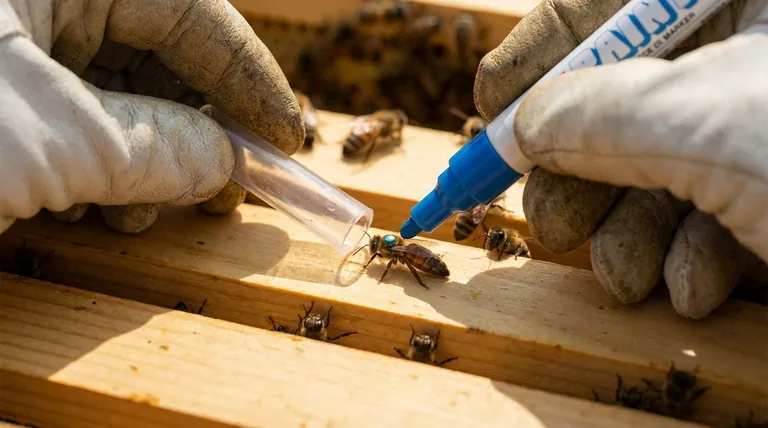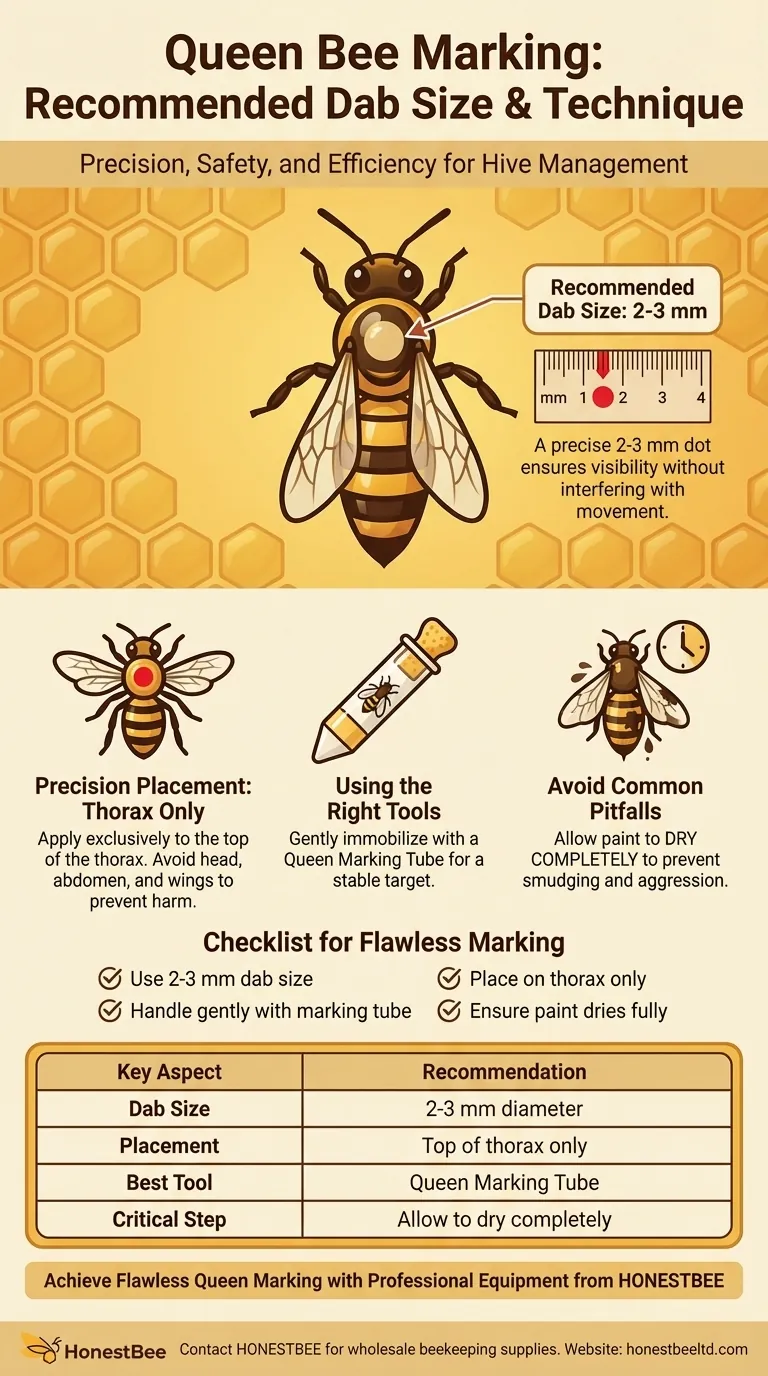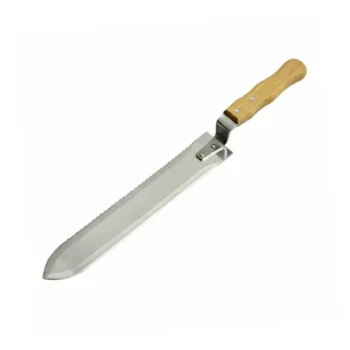The recommended size for the paint dab when marking a queen bee is a small, precise dot approximately 2-3 mm in diameter. This ensures the mark is large enough to be easily visible during hive inspections but small enough that it doesn't interfere with the queen's movement or her interactions with other bees.
Successful queen marking is a matter of precision, not just size. The core objective is to create a durable, visible mark on the queen's thorax while ensuring her complete safety through proper handling and technique.

The Principles of Safe and Effective Marking
Marking a queen bee is a fundamental skill in beekeeping. It allows you to quickly identify her, track her age, and assess the status of your colony with minimal disruption. However, the process must be done correctly to avoid harming the queen.
The Critical Role of Dab Size
A dab of paint that is 2-3 mm across is the established standard. A mark this size is easily seen against the backdrop of the comb and other bees.
If the mark is too large, it risks covering other parts of her body. If it's too small, its purpose is defeated as you will struggle to find it later.
Precision Placement: The Thorax Only
The paint must be applied exclusively to the top of the queen's thorax. The thorax is the hard, middle section of her body between the head and the abdomen.
Never apply paint to her head, abdomen, or wings. Paint in these areas can block her sensory organs, interfere with her breathing or egg-laying, or impede her ability to fly.
Using the Right Tools for Control
To apply a clean, perfectly-sized dab, the queen must be gently immobilized. A Queen Marking Tube is a highly recommended tool for this purpose.
This device allows you to gently confine the queen against a soft screen with a sponge plunger. This holds her still, presenting the thorax as a stable target for the marking pen.
Common Pitfalls to Avoid
Even with the correct size and placement, small errors in the process can lead to problems. Understanding these risks is key to ensuring the queen is returned to the colony safely.
The Danger of Smudging
The paint must be allowed to dry completely before you release the queen back into the hive. This is a critical step.
If the paint is still wet, it can easily smudge onto her wings, eyes, or antennae. It can also rub off onto other worker bees, which can cause confusion or aggression toward the queen.
Inefficient Handling
Handling the queen is a rare opportunity. Once she is safely isolated for marking, you can use the time efficiently.
Many beekeepers use this moment to perform a quick mite count using a sugar shake or alcohol wash on a sample of other bees. This helps you complete two essential tasks with a single hive opening.
Checklist for a Flawless Marking
Apply these principles to ensure your queen marking is safe, effective, and beneficial for your hive management.
- If your primary focus is visibility and tracking: Use the 2-3 mm dab size and ensure you are using the correct international color code for the year.
- If your primary focus is queen safety: Handle her gently, use a dedicated tool like a marking tube to immobilize her, and always place the dot exclusively on her thorax.
- If your primary focus is a durable, clean mark: Give the paint several minutes to dry completely before releasing the queen to prevent any smudging.
Mastering this simple procedure will give you invaluable insight into the health and productivity of your hive.
Summary Table:
| Key Aspect | Recommendation |
|---|---|
| Dab Size | 2-3 mm in diameter |
| Placement | Top of the queen's thorax only |
| Best Tool | Queen Marking Tube for precision |
| Critical Step | Allow paint to dry completely before release |
Achieve Flawless Queen Marking with Professional Equipment from HONESTBEE
Marking your queens is essential for efficient apiary management. Using the right tools ensures the safety of your valuable queens and the accuracy of your records. HONESTBEE supplies commercial apiaries and beekeeping equipment distributors with high-quality, wholesale-focused supplies designed for precision and durability.
Let us help you protect your investment and streamline your operations. Contact HONESTBEE today to explore our range of queen marking tubes, paints, and other essential beekeeping equipment.
Visual Guide

Related Products
- Queen Bee Marking Pen UNI Medium Point for Queen and Bee Marking
- Professional Engraved Round Hive Number Tags for Beekeeping
- HONESTBEE Advanced Ergonomic Stainless Steel Hive Tool for Beekeeping
- Professional Dual-End Stainless Steel Hive Tool for Beekeeping
- Plastic Chinese Queen Grafting Tool for Bee Queen Rearing
People Also Ask
- What type of markers are commonly used for marking Queen bees? Choose the Safe, Non-Toxic Standard
- What are the color codes in the queen-marking system? Master Hive Management with the 5-Year Cycle
- Why is marking a Queen bee important for beekeepers? Elevate Your Apiary Management
- What are the advantages of using Uni-Posca markers for Queen marking? A Safe, Precise, and Efficient Solution
- What are the characteristics of Posca pens for marking queens? A Safe, Durable Solution for Hive Management



















